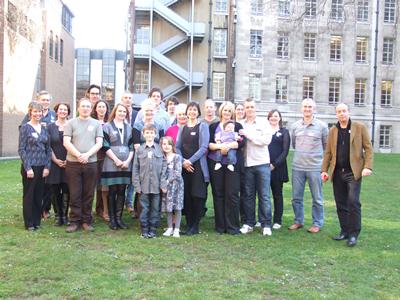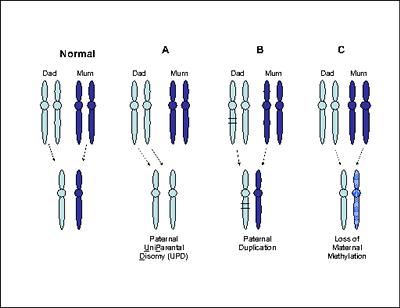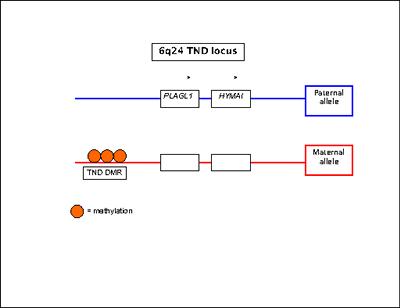
What is 6q24 TND?
6q24-related TND is caused by the overactivity (overexpression) of genes (PLAGL1, HYMAI) in a region of the long (q) arm of chromosome 6 called 6q24.
There are three ways that overexpression of imprinted genes in the 6q24 region can occur (these are demonstrated in the diagram on the right of this page). About 40 percent of cases of 6q24-related transient neonatal diabetes mellitus are caused by a genetic change known as paternal uniparental disomy (UPD) of chromosome 6. In paternal UPD, people inherit both copies of the affected chromosome from their father instead of one copy from each parent. Paternal UPD causes people to have two active copies of paternally expressed imprinted genes, rather than one active copy from the father and one inactive copy from the mother.
Another 40 percent of cases of 6q24-related transient neonatal diabetes mellitus occur when the copy of chromosome 6 that comes from the father has a duplication of genetic material including the paternally expressed imprinted genes in the 6q24 region.
The third mechanism by which overexpression of genes in the 6q24 region can occur is by impaired silencing of the maternal copy of the genes (maternal hypomethylation).
Approximately 20 percent of cases of 6q24-related transient neonatal diabetes mellitus are caused by maternal hypomethylation. Some people with this disorder have a genetic change in the maternal copy of the 6q24 region that prevents genes in that region from being silenced. Other affected individuals have a more generalized impairment of gene silencing involving many imprinted regions, called hypomethylation of imprinted loci (HIL). This is sometimes referred to a the Hypomethylation syndrome.About half the time, HIL is caused by recessive mutations in the ZFP57 gene. Studies indicate that the protein produced from this gene is important in establishing and maintaining gene silencing.
The other causes of HIL are unknown. Because HIL can cause overexpression of many genes, this mechanism may account for the additional health problems that occur in some people with 6q24-related transient neonatal diabetes mellitus.
It is not well understood how overexpression of PLAGL1 and other genes in the 6q24 region causes 6q24-related transient neonatal diabetes mellitus and why the condition improves after infancy. The protein produced from the PLAGL1 gene helps control another protein called the pituitary adenylate cyclase-activating polypeptide receptor (PACAP1), and one of the functions of this protein is to stimulate insulin secretion by beta cells in the pancreas. In addition, overexpression of the PLAGL1 has been shown to stop the cycle of cell division and lead to the self-destruction of cells (apoptosis). Researchers suggest that PLAGL1 gene overexpression may reduce the number of insulin-secreting beta cells or impair their function in affected individuals.
Lack of sufficient insulin results in the signs and symptoms of diabetes mellitus. In individuals with 6q24-related transient neonatal diabetes mellitus, these signs and symptoms are most likely to occur during times of physiologic stress, including the rapid growth of infancy, childhood illnesses, and pregnancy. Because insulin acts as a growth promoter during early development, a shortage of this hormone may account for the intrauterine growth retardation seen in 6q24-related transient neonatal diabetes mellitus.
The Wessex Imprinting Group established the major genetic causes of TNDM with key work on the imprinted locus of the q arm of chromosome 6.

How common is 6q24 TND?
Between 1 in 215,000 and 1 in 400,000 babies are born with diabetes mellitus. In about half of these babies, the diabetes is transient. Researchers estimate that approximately 70 percent of transient diabetes in newborns is caused by 6q24-related transient neonatal diabetes mellitus

